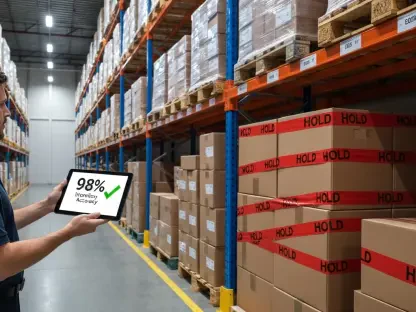Walmart’s recent announcement of new multichannel logistics and cross-border fulfillment services marks a significant step in its strategic evolution. By unveiling these innovative services at the “Let’s Grow! 2024 Walmart Marketplace Seller Summit,” Walmart clearly signals its ambition to compete with Amazon in the third-party logistics (3PL) realm, an area where Amazon has long held sway. This initiative aims to simplify and streamline fulfillment processes for sellers while providing cost-effective, reliable solutions.
Walmart’s Multichannel Logistics Solution
Leveraging Walmart Fulfillment Services (WFS)
Walmart’s Multichannel Solutions program capitalizes on its existing Walmart Fulfillment Services (WFS) to handle orders from various eCommerce platforms far beyond Walmart’s marketplace. This move allows sellers to benefit from Walmart’s expansive supply chain network, which includes features such as unbranded packaging, fast shipping options, and competitive pricing structures approximately 15% lower than industry averages. This service is set to launch on September 10, perfectly timed to align with the bustling holiday season, which is expected to drive substantial market activity.
The implementation of Walmart’s multichannel logistics marks a pivotal shift in its business model. No longer confined to its own platform, Walmart now offers logistics services to sellers using other eCommerce channels, enabling a more versatile approach to order fulfillment. With unbranded packaging, the service ensures a seamless experience for end customers, regardless of the marketplace from which they purchase. This flexibility, combined with rapid shipping options, allows sellers to meet consumer expectations more efficiently. The competitive pricing not only makes Walmart an attractive option for cost-conscious sellers but also puts pressure on other 3PL providers to reevaluate their pricing strategies.
Cost-Effective and Efficient Operations
Sellers utilizing Walmart’s multichannel logistics can expect significant improvements in operational efficiency. By leveraging Walmart’s robust logistics network, sellers can reduce handling times and shipping costs, making their operations more streamlined and efficient. The competitive pricing offered by Walmart is a major draw, allowing sellers to allocate their resources more effectively and focus on other aspects of their business growth. By handling logistics and fulfillment operations with greater efficiency, sellers can devote more time and resources to marketing, product development, and customer service.
The integration with Walmart Fulfillment Services ensures that sellers benefit from a well-established logistics infrastructure. This integration minimizes the complexities associated with managing multiple fulfillment channels, offering a unified solution that simplifies the logistics landscape for sellers. Furthermore, the seamless transition into the holiday season provides sellers with an opportunity to capitalize on peak demand without the logistical hiccups that typically accompany high-volume periods. This holistic approach underlines Walmart’s commitment to enhancing seller operations, making it an indispensable partner for businesses aiming to scale efficiently.
Cross-Border Fulfillment Services
Full-Container-Load Shipments from Asia
Walmart’s new cross-border import service is designed to manage the transportation of full-container-load shipments from Asia directly to its U.S. facilities. By tapping into Walmart’s carrier network, sellers can choose full truckload shipments at preferential rates through vetted Walmart carriers. This service offers greater flexibility for businesses by accommodating various shipment sizes and ensuring cost-effective transportation solutions. The ability to handle full-container-load shipments significantly reduces the logistical burden on sellers, allowing them to focus on core business activities while Walmart manages the complexities of international shipping.
The cross-border fulfillment initiative is an important step in Walmart’s strategic goal of globalizing its logistics capabilities. By facilitating the movement of goods from Asia, Walmart addresses a critical need for sellers who rely on international supply chains. The vetted carrier network ensures that shipments are handled with the highest standards of reliability and efficiency, minimizing the risks associated with long-distance transportation. Sellers can thus benefit from Walmart’s established relationships with international carriers, gaining access to preferential rates and robust logistics support. This initiative not only streamlines cross-border operations but also enhances sellers’ ability to compete in the global marketplace.
Enhancing Global Supply Chain Dynamics
This cross-border fulfillment initiative underscores Walmart’s commitment to globalization and providing comprehensive logistics solutions. Managing full-container-load shipments from Asia not only streamlines international logistics but also helps sellers overcome barriers associated with global supply chains. Walmart’s focus on seamless cross-border fulfillment positions it as a reliable partner for businesses looking to expand internationally. By addressing the logistical challenges of cross-border shipping, Walmart enables sellers to reach a broader customer base without the associated complexities and costs.
The initiative also highlights Walmart’s strategic foresight in anticipating the needs of global commerce. By offering solutions that simplify international logistics, Walmart positions itself as a key player in the modernization of global supply chains. This focus on enhancing global supply chain dynamics is essential in today’s interconnected market, where businesses must navigate complex international regulations and diverse consumer demands. Walmart’s cross-border fulfillment services provide sellers with the tools they need to efficiently manage their supply chains, reduce costs, and improve delivery timelines. As a result, sellers can achieve better market penetration and elevate their competitive edge on a global scale.
Strategic Market Positioning
Increased Control Over Logistics
Retail giants like Walmart and Amazon are increasingly viewing logistics as a core strategic function. This shift motivates investments into assets, technology, and resources to gain direct control over their supply chain operations. These investments not only boost their own operational efficiencies but also offer new revenue streams by marketing these logistics capabilities to smaller businesses that may lack the means to develop such infrastructure independently. By controlling the logistics process from end to end, Walmart and Amazon can deliver more predictable and reliable service levels to their customers.
Walmart’s strategic investment in logistics infrastructure signifies its commitment to transforming its role from a traditional retailer to a comprehensive logistics provider. By acquiring assets, deploying advanced technology, and optimizing resources, Walmart aims to gain a competitive advantage in the logistics arena. This increased control over logistics operations allows Walmart to offer tailored solutions that meet the specific needs of various sellers. As a result, Walmart elevates its value proposition in the market, becoming an attractive option for businesses seeking efficient and scalable logistics solutions.
Diversification and Competitive Positioning
Walmart’s expansion into logistics services signifies a tactical approach to diversification, attracting small and mid-size businesses (SMBs) that often lack extensive logistical resources. Offering cost-effective, reliable fulfillment services allows Walmart to position itself competitively against Amazon, seeking to level the playing field and capture a larger market share. By broadening its service portfolio, Walmart aims to create multiple revenue streams, enhancing its profitability and resilience against market fluctuations.
The decision to diversify into logistics is a calculated move to capitalize on the growing demand for efficient eCommerce fulfillment. SMBs, which traditionally struggle with high logistics costs and limited resources, find Walmart’s offerings particularly appealing. The cost-effective logistics solutions provided by Walmart enable SMBs to scale their operations without significant capital investments, fostering a more inclusive and competitive market environment. This strategic diversification not only strengthens Walmart’s market positioning but also disrupts the traditional 3PL landscape, compelling other providers to innovate and adapt to the changing market dynamics.
Support for Small and Mid-Sized Businesses (SMBs)
Tapping into Underserved Market Segments
Traditional third-party logistics providers have historically focused on larger clients, often neglecting the SMB market. This oversight created a niche that Walmart and Amazon are now filling with their hybrid business models. By focusing on SMBs, these retail giants offer faster-to-deploy and more flexible solutions compared to traditional 3PLs, making them attractive options for smaller sellers. This strategic orientation towards underserved market segments allows Walmart to tap into a new customer base that has been largely ignored by conventional logistics providers.
Walmart’s focus on SMBs is a direct response to a market gap that has long been overlooked. By providing solutions that cater specifically to the needs of smaller businesses, Walmart addresses a crucial pain point in the logistics industry. The hybrid approach, combining the strengths of traditional retail with advanced logistics capabilities, offers SMBs a unique value proposition. These businesses can now access high-quality logistics services without the prohibitive costs typically associated with 3PL providers. Walmart’s initiative underscores its commitment to fostering inclusivity and supporting the growth of SMBs, which are vital contributors to the economy.
Fostering a Supportive Ecosystem
Walmart’s initiative reflects a broader trend where logistics providers view startups and entrepreneurs as viable partners rather than just clients. By aligning with startups, traditional 3PLs can mitigate risks through vested outsourcing agreements, ensuring long-term profitability. Supporting new businesses helps logistics companies preemptively address concerns investors might have about logistics and supply chain efficiency, fostering a more supportive ecosystem for entrepreneurship. This symbiotic relationship benefits both parties, creating opportunities for innovation and growth within the logistics sector.
The supportive ecosystem fostered by Walmart’s initiative extends beyond logistics, encompassing various aspects of business operations. By providing comprehensive support to startups and entrepreneurs, Walmart creates an environment conducive to innovation and sustainability. This collaborative approach not only enhances the growth prospects for new businesses but also drives Walmart’s own strategic objectives. The alignment with startups allows Walmart to stay at the forefront of industry trends, adopting new technologies and practices that improve its logistics operations. Ultimately, this supportive ecosystem benefits the entire business community, driving economic growth and development.
Implications for the Logistics Industry
Retail Giants Entering Logistics
Walmart and Amazon’s entry into the logistics industry marks a significant shift in the retail landscape. By developing comprehensive logistics services, these retailers are not only enhancing their operational footprint but also disrupting traditional logistics providers. This shift offers sellers a reliable and affordable option to streamline their operations and improve their competitiveness in the eCommerce market. The entry of retail giants into logistics underscores the evolving dynamics of the industry, where efficiency and cost-effectiveness are paramount.
The incursion of retail giants into the logistics sector represents a paradigm shift that challenges established norms. Traditional logistics providers, accustomed to serving large clients, must now compete with the holistic solutions offered by Walmart and Amazon. This competition drives innovation and efficiency, ultimately benefiting sellers who gain access to superior logistics services at lower costs. The comprehensive logistics offerings from retailers like Walmart redefine the value chain, integrating logistics and retail operations to deliver a seamless customer experience. This integration positions Walmart as a formidable player in the logistics industry, capable of setting new standards for service and efficiency.
Enhancing Seller Operations
Walmart’s recent rollout of new multichannel logistics and cross-border fulfillment services signals a substantial leap in its strategic growth. Announced during the “Let’s Grow! 2024 Walmart Marketplace Seller Summit,” this move positions Walmart to rival Amazon in the third-party logistics (3PL) space, a sector where Amazon has long been dominant. Walmart aims to revolutionize how sellers manage their fulfillment processes, making it more straightforward and efficient. The new services promise cost-effective and dependable solutions, providing an attractive alternative for businesses looking to streamline their operations and reach a broader audience.
By focusing on multichannel logistics, Walmart is addressing the growing need for integrated supply chain solutions. This can offer sellers quicker and more reliable ways to get products to customers, which is crucial in today’s fast-paced eCommerce environment. The introduction of cross-border fulfillment services also highlights Walmart’s commitment to helping sellers expand their reach globally, providing tools and resources to navigate international shipping complexities.
In summary, Walmart’s latest initiative underscores its determination to compete head-to-head with Amazon, aiming to attract more sellers to its platform by offering robust, cost-effective logistics solutions. This could ultimately reshape the landscape of 3PL services, benefiting both sellers and consumers with more choices and better service.









